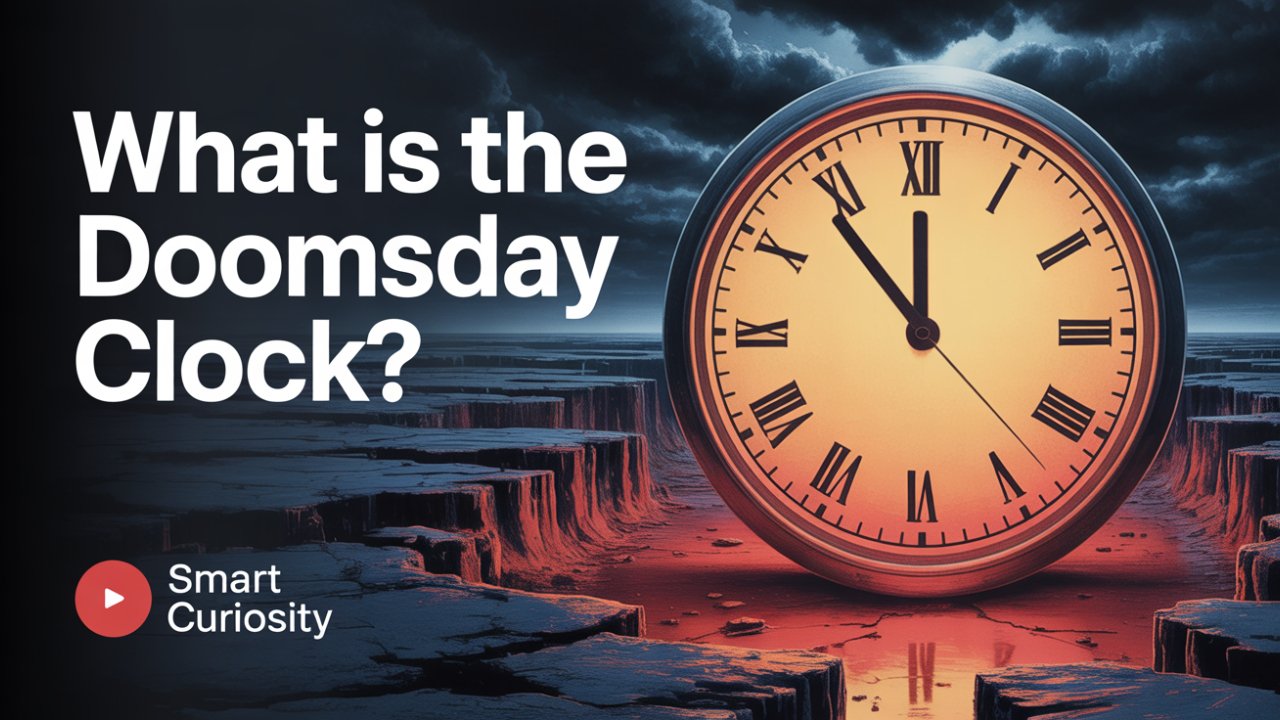Picture a clock. Not the one on your phone, and definitely not one you’d want on your wall. This clock wasn’t built to tell you the time of day. It was built to tell you the time of our world.
It’s a symbolic countdown, a stark, visual metaphor for how close humanity is to causing its own annihilation. On this clock, midnight is the end. Midnight is global catastrophe. This is the Doomsday Clock, and its hands are moved by the choices we make and fail to make as a species.
For over 75 years, this clock has been a silent, ticking conscience for the planet. Think of it less as a prediction and more as a diagnosis of our world’s health, made by the very experts who best understand the threats we face. The story of this clock is our story. It’s a wild tale of incredible genius and catastrophic foolishness, of moments we stared into the abyss and pulled back, and of times, like right now, where we find ourselves standing uncomfortably close to the edge.
This is the Doomsday Clock. And right now, it’s set at 89 seconds to midnight.
This isn’t just a number. It is the closest it has ever been to the symbolic point of no return. Closer than during the darkest days of the Cold War, closer than any other time in its history. So, what exactly is this clock? And how did we get here, to this moment of unprecedented danger? To figure that out, we have to go back to its secret origins, born from the minds of the same scientists who unleashed the atomic bomb on the world.
The year is 1945. The world is crawling out from the wreckage of World War II, scarred but hopeful. But a new and terrible fear was casting a long shadow over that hope. The United States had dropped two atomic bombs on Hiroshima and Nagasaki, ending the war with a horrifying, world-altering bang. In a flash, the very nature of power, war, and existence had changed forever. Humanity had figured out how to weaponize the sun.
The architects of this terrifying new power were the scientists of the Manhattan Project some of the most brilliant minds on Earth, like J. Robert Oppenheimer and Albert Einstein. They’d raced to build the bomb because they feared Nazi Germany would get it first. But after seeing it used, many were gripped by a profound sense of dread and responsibility. They had witnessed the fire, and they knew it could easily consume the world.
Oppenheimer, the “father of the atomic bomb,” famously quoted the Bhagavad Gita after the first atomic test: “Now I am become Death, the destroyer of worlds.” This wasn’t a boast; it was a lament. He and his colleagues knew they’d started something that could lead to the end of civilization.
Out of this anxiety, a new movement was born. A group of these scientists at the University of Chicago banded together. Their mission wasn’t physics anymore; it was survival. They felt a moral duty to warn the public about the monster they had helped create. They started a newsletter, which by 1947 had become a full-blown magazine: the Bulletin of the Atomic Scientists.
For the cover of their June issue, they needed an image that would grab people by the collar. Co-founder Hyman Goldsmith asked an artist, Martyl Langsdorf, to design it. She happened to be married to another Manhattan Project physicist, so she was surrounded by these urgent conversations. Langsdorf thought about using the chemical symbol for uranium but landed on something far more powerful: a clock.
A clock is a countdown. Everyone gets that. She sketched a simple clock face, showing only the last 15 minutes. Then came the big question: what time should it be? This wasn’t a scientific calculation; it was a gut feeling. An artistic choice. Weighing the gravity of the new nuclear age, she set the hand at seven minutes to midnight. Why seven? As she later said, “it looked good to my eye.” It felt urgent, but not totally hopeless. Seven minutes. A tiny buffer for humanity to get its act together.
And just like that, the Doomsday Clock was born. Not as a crystal ball, but as a logo for the nuclear age. It was a piece of art designed, in the words of the Bulletin’s first editor, to “frighten men into rationality.” The scientists who knew the bomb best were trying to scare the world straight. They knew the bomb wasn’t just another weapon; it was a potential full stop at the end of humanity’s sentence. The clock was their warning that we were all living on borrowed time.
For its first two years, the Doomsday Clock stayed put at seven minutes to midnight. It was a baseline of danger. But the world wasn’t standing still. The Cold War was heating up, and the nuclear shadow was spreading. The scientists realized their clock couldn’t be a static image; it had to move with the times. It needed to be a real-time indicator of how much trouble we were in.
The first big jump came in 1949. The clock lurched forward to just three minutes to midnight. The reason was a political earthquake: the Soviet Union had tested its own atomic bomb. The American monopoly was over. The arms race was on. Now there were two fingers on the nuclear button. The world had just gotten a whole lot more dangerous, and the clock showed it.
But it was about to get even worse. In the early 1950s, both the U.S. and the Soviet Union developed the hydrogen bomb a weapon of truly apocalyptic power. This wasn’t just a bigger bomb; it was like upgrading from a firecracker to a volcano. In response, in 1953, the Bulletin moved the hands to two minutes to midnight. This was the closest the clock had ever been to Doomsday, a record that would stand for 65 years. For nearly a decade, the world teetered on this two-minute edge.
Yet, even then, the clock proved it could also move backward. The sheer terror of the H-bomb forced a little bit of sanity into the world. By 1960, a slight thaw in relations and more scientific cooperation allowed the Bulletin to move the clock back to seven minutes.
The most significant step back from the brink came in 1963. The Cuban Missile Crisis had brought the world terrifyingly close to actual nuclear war. Having stared into the abyss, the U.S. and Soviet leaders were ready to talk. They signed the Partial Nuclear Test Ban Treaty, a landmark arms control agreement. In recognition of this huge step, the Bulletin moved the clock way back to twelve minutes to midnight. It was a powerful message: diplomacy works. The countdown can be reversed.
The clock danced back and forth for years, moving forward during the Vietnam War and when more countries got the bomb, and backward in the 70s with more arms treaties. Then came the 80s, and things got frosty again. In 1984, with US-Soviet relations at a low point, the clock was pushed to three minutes to midnight.
But then, something amazing happened. The Berlin Wall fell. The Iron Curtain collapsed. The Cold War just… ended. In 1991, as the U.S. and the newly-formed Russia signed a treaty to slash their nuclear arsenals, the Bulletin made its most optimistic move ever. The hands of the Doomsday Clock were wound back to seventeen minutes to midnight the safest humanity has ever been in the clock’s history. For a brief, shining moment, it felt like the world had dodged the ultimate bullet. It was a beautiful thought. It wouldn’t last.
For a few glorious years in the early 90s, the world relaxed at a comfortable 17 minutes to midnight. But the end of the Cold War didn’t mean the end of danger. It just meant the dangers got more complicated. Nuclear proliferation was still a problem, and the clock slowly started creeping forward again.
Then, in 2007, the Bulletin of the Atomic Scientists made a huge change. For 60 years, the clock had basically been about one thing: nuclear war. But the expert board recognized that humanity was cooking up another existential threat, one that was slower but just as capable of ending civilization. For the first time, they officially added climate change to the Doomsday calculation.
This wasn’t a decision they took lightly. They saw clear evidence that a rapidly warming planet with its extreme weather, rising seas, and disrupted ecosystems was a direct threat to global stability. Climate change, they argued, is a “threat multiplier.” It can cause wars over resources, create waves of refugees, and destabilize societies, making nuclear conflict more likely. So in 2007, the clock jumped forward from seven minutes to five. The age of “twin threats” had arrived.
As the years went by, we didn’t make much progress on either front. Arms control treaties faded away while global carbon emissions kept rising. The clock ticked closer: three minutes, then two and a half. In 2018, it hit two minutes to midnight, tying the old Cold War record.
But the threat list was still growing. Scientists were now forced to confront a third category of danger: disruptive technologies. Think of it as a web of risks from tech that’s advancing way too fast for us to control. In 2020, the Bulletin moved the clock into uncharted territory, setting it at 100 seconds to midnight.
What kind of tech? For starters, Artificial Intelligence. Specifically, AI in the military. Autonomous drones, AI-powered command networks they all raise the terrifying possibility of war fought at machine speed, without a human in the loop. A single bug or a bad algorithm could trigger a catastrophe in seconds.
Then there’s biotechnology. Gene editing is incredible, but it also carries the risk of creating new, super-dangerous diseases, either by accident or on purpose as a bioweapon. The COVID-19 pandemic was a brutal real-world test that showed just how unprepared we are for a major biological crisis.
And weaving through all of it is the poison of misinformation and disinformation, supercharged by the internet. How can we solve any of these huge problems when we can’t even agree on basic facts? This “corruption of the information ecosphere,” as the Bulletin calls it, paralyzes our ability to respond to any crisis.
So the picture was no longer just about the bomb. It was a tangled mess of threats: a new arms race, a burning planet, and runaway technology that could automate war and shatter our sense of reality. And the hands of the clock were about to move again.
And that brings us to today. The Bulletin of the Atomic Scientists has now set the Doomsday Clock at 89 seconds to midnight.
Eighty-nine seconds. We’ve blown past minutes. We are now counting the final moments on the symbolic dial. This is the closest to midnight the clock has ever been. It’s an unmistakable declaration from the experts that humanity is facing a moment of “unprecedented danger.” This isn’t a drill.
So why now? Why this terrifying new setting? It’s not one single thing, but a perfect storm of negative trends all hitting at once.
First, and most immediate, is the war in Ukraine. This is a conflict involving a nuclear-armed state that has repeatedly made veiled nuclear threats and has fought battles around nuclear power plants. The risk of things escalating into a nuclear exchange, whether by choice or by a horrible accident, is frighteningly real. Beyond Ukraine, a new three-way arms race is kicking off between the U.S., Russia, and China, who are all spending fortunes to upgrade their nuclear arsenals. The era of arms control treaties that once gave us hope is basically over.
Second, the climate crisis isn’t a future problem; it’s here. 2023 was the hottest year on record, and we’re seeing the consequences everywhere: historic floods, raging wildfires, and deadly heatwaves are the new normal. And yet, the global response has been, to put it mildly, pathetic. We are failing to transition away from fossil fuels at the speed required to avoid catastrophe.
Third, those disruptive technologies are getting more dangerous, faster than we can regulate them. The use of AI in weapons systems could create lethal autonomous weapons killer robots, essentially that make life-or-death decisions without human control. AI-powered disinformation is also making it nearly impossible to have rational public debates. Meanwhile, the same tools that could create new medicines could also be used to design new bioweapons.
This is why you should care. The Doomsday Clock isn’t some nerdy academic exercise. It’s the Earth’s fever chart, and the temperature is spiking. It represents the very real dangers of nuclear war, a collapsing climate, and technology that has outpaced our wisdom. These aren’t separate problems; they all feed each other. And right now, every warning light is flashing red.
Eighty-nine seconds. It’s a scary number. It sounds final. But the whole point of the Doomsday Clock is that midnight is not inevitable. The clock is a warning, not a prophecy. Its hands are moved by people. And if our bad decisions can move them forward, our good decisions can move them back.
The Bulletin doesn’t set the clock to make us despair; they set it to spark action. It’s a global fire alarm, meant to wake us all up.
So what does turning back the clock even look like? It means world leaders especially in the U.S., Russia, and China need to start talking again. It means rebuilding arms control, reducing the role of nuclear weapons, and creating guardrails to prevent war. It means taking the climate crisis seriously with massive, urgent investments in clean energy and real, binding commitments to cut emissions. And it means creating smart, international rules for new technologies like AI and biotech, to make sure they’re used to help humanity, not destroy it.
These are huge tasks, and it’s easy to feel powerless. But the clock’s own history shows us that change is possible. The world pulled back from the brink in 1963 and again in 1991 because leaders chose diplomacy and because ordinary citizens demanded a better, safer world.
That power is still ours. The leaders we elect, the policies we support, and the way we talk about these issues all matter. Staying informed and demanding action from our representatives are real ways to help push those hands away from midnight.
The challenges are massive, but so is our capacity for smart solutions and teamwork. To learn more about the specific steps we can all take and to read the detailed analysis behind the clock’s setting, you should absolutely check out the website for the Bulletin of the Atomic Scientists.
And if you found this breakdown of the Doomsday Clock helpful, please subscribe to our channel. We’re dedicated to exploring the most critical issues shaping our world, one fascinating, terrifying, and hopeful story at a time. We end where we began. Eighty-nine seconds to midnight. A stark symbol for a deeply unstable world. The Doomsday Clock is more than an icon; it’s a mirror. It reflects a world grappling with nuclear risk, a burning climate, and technologies that are running wild. It reminds us that the greatest threat to humanity has always been humanity itself. The clock is ticking. But it is not midnight. Not yet. The only question left is: which way will we choose to move the hands next?





